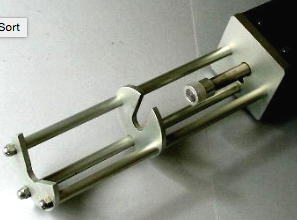The “Cook” Gas-Operated Dye Injector
Ref. L10



Before electric and electronically controlled injectors came into common use in vascular radiology, gas operated high pressure dye injectors were the state of the art in the sixties and the seventies, and the “Cook” was one of them. It was in high esteem and considered, in spite of its simplicity and its draw-backs, as one of the most reliable. Three syringe sizes were available: 50, 75 and 100 mL.
Description
From the 1967 Cook Catalog: “:…..It consists of a pneumatic piston mounted on a chassis which holds a metal syringe. The piston is controlled by a variable pressure-regulating valve and foot valve. When the foot valve is depressed, the gas passes to the piston cylinder which applies thrust to the syringe. Release of the foot valve completes the cycle”.
Advantages: Simplicity. Reliability. No down-time.
Drawbacks: Injection rate depends on the gas pressure in the gas cylinder, the size of the syringe, and dimensions of the catheter. Unavailability of disposable syringes.
The injector shown has served for many years. Thereafter it remained on “stand by” and was occasionally used when more sophisticated injectors needed servicing. Its use was totally abandoned in the eighties.
1967 Price-List
Injector with one multiple injection syringe (any size), two-stage variable pressure regulator, foot-valve with air hose and instructions: $545.
Extra syringes, any size, each $125.